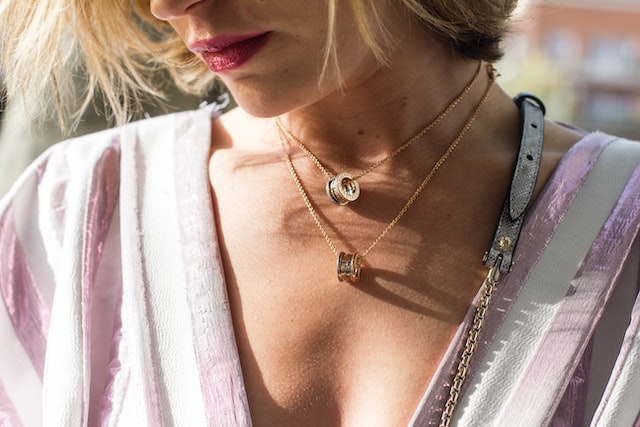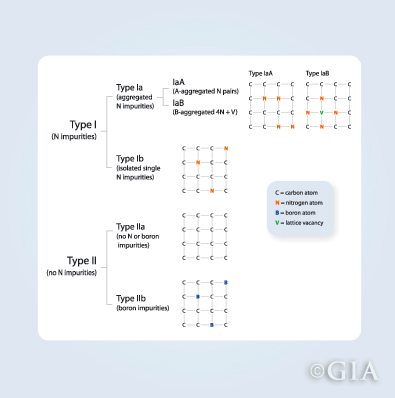
Birthstone Guide and Chart
November 1, 2022
The Five Most Impressive Diamond Jewelry Trends for 2023
January 31, 2023A Guide to Different Types of Diamonds

Everyone knows diamonds are made of pure carbon. However, this is actually a common misconception. Yes, diamonds are made of carbon, but that doesn’t mean they don’t contain other chemicals. Did you know there are different types of diamonds classified by their chemical makeup?
Over the vast periods of time it takes to produce a natural diamond, these stones can develop impurities due to the presence of other chemicals such as nitrogen or boron.
So how does this affect how they are classified? What even is diamond classification anyway? Here’s what you need to know about different types of diamond.
- Diamond Classifications
- What Are The Different Types of Diamond?
- Are There Other Types of Diamond?
- What Type of Diamond is the Best?
Diamond Classifications
Diamond classification is an interesting scale based upon the chemical composition of a diamond itself. A pure diamond is pure carbon, but these are actually quite rare. As you can imagine, as it takes hundreds of thousands if not millions of years to form a diamond, there’s a lot of opportunities for a diamond to be ‘tainted’ by the presence of a foreign chemical.
The presence of other chemicals in a diamond is what influences how they are classified. This classification helps inform gemologists of the quality of the diamond, and also how they differentiate between natural, treated, and lab-grown diamonds.
What Are the Different Types of Diamond?
We can classify diamonds into two types:
- Type I, which contains nitrogen impurities.
- Type II, which do not contain nitrogen impurities.
These can further be divided into five sub-categories:
- Type Ia
- Type IaA & IaB
- Type Ib
- Type IIa
- Type IIb

What differentiates these is the type of chemical impurities they contain. Here’s a brief rundown of each one:
Type Ia
Type Ia diamonds are categorised by the inclusion of clustered nitrogen atoms. These are the most common type of diamond, making up around 95% of all the diamonds naturally formed. They come in a wide range of colors, from the near-colorless variety (graded as G, H, I, or J on the GIA color scale), to lightly coloured (from K to R). Many of them have a slight yellow tint, due to the presence of the nitrogen itself. When light is passed through them, they will often displace blue-colored fluorescence.
Type IaA & IaB
Type IaA and IaB are just small sub-categories of Type Ia. All this is is a difference between nitrogen atoms that form in pairs of two (Type IaA) and nitrogen atoms that form in pairs of fours (Type IaB), which produces different hues.
Type Ib
In contrast to how common Type Ia diamonds are (relative to the diamond world), Type Ib represent less than 0.1% of naturally-formed diamonds. They also contain trace amounts of nitrogen, but the key difference between these and Type Ia is that how the nitrogen is placed. In Type Ia, the nitrogen is clustered, whereas in Ib, nitrogen atoms are scattered and ‘looser’ within the diamond’s structure.
Because of this formation of nitrogen, with their atoms more dispersed throughout the body of the diamond, Type Ib are known to be colored with deep shades of brown, yellow, or even orange.
Type IIa
Type IIa, known as ‘Golconda diamonds’ (named after an area in India famous for diamond production) are the most popular types of diamond. They make up around one percent of all natural diamonds and are fortunate enough to contain no measurable impurities. Due to their chemical purity, these are the diamonds most wanted by investors, collectors, and retailers. More often than not, they have a D color grading (the best possible), high clarity grades and no fluorescence.
These diamonds are actually not all colorless. During the formation process, some undergo what is called ‘plastic deformation’ which alters the structure of the diamond’s crystal lattice. This has the ability to create blue, red, or pink hues.
Type IIb
Like Type Ib, Type IIb are incredibly rare, making up no more than 0.1% of all diamonds. This type of diamonds do not contain nitrogen atoms, but rather born atoms. This has the strange, and rather compelling effect of giving the diamonds a light blue or gray color. They are very popular among collector circles.
Another compelling change the boron atoms produce in the diamond is to make them able to conduct electricity. Just another bit of chemical magic that diamonds can produce.
Are There Other Types of Diamond?
There are many chemical differences in diamonds that each requires their own moniker and explanation, but these, like the types referred to above, are only really pertinent to gemologists. The four types of diamonds that consumers need to be aware of are:
- Natural diamonds: Those formed naturally over the course of millions of years.
- Lab diamonds: Diamonds that are produced in laboratories either through Chemical Vapor Deposition (CVD) or High-Pressure High-Temperature (HPHT).
- Natural Colored Diamonds: These are diamonds that are naturally formed but come in a wider variety of colors, such as pink, red, blue and orange.
- Treated diamonds: These diamonds are artificially enhanced to improve their visual appeal. This might be in the form of HPHT, fracture filling or laser drilling.
What Type of Diamond is The Best?
In all honesty, the classification of diamond doesn’t matter much to an everyday buyer. The only classifications you need to take into account are the Four Cs, the ultimate features that determine a diamond’s quality. Getting to grips with the ins and outs of the Four Cs is the best way of learning how to sort the good diamonds from the bad during your search for either loose diamonds or diamond jewelery.
Ultimately, the best diamond is the one you like the most, with the best attributes available within your budget. Of course, there are good deals and bad deals, but what you buy is up to you. But remember, look for one with a GIA grading report that proves the diamond is as described.
Discover the Four Cs
The key to a good diamond purchase is finding the best deal. And the key to finding the best deal? Doing your research. The best place to start this research is right here at Your Diamond Guru.
I suggest reading my reviews on Whiteflash, James Allen and Brilliant Earth to start, as well as this article on trade ups and light performance images respectively.


